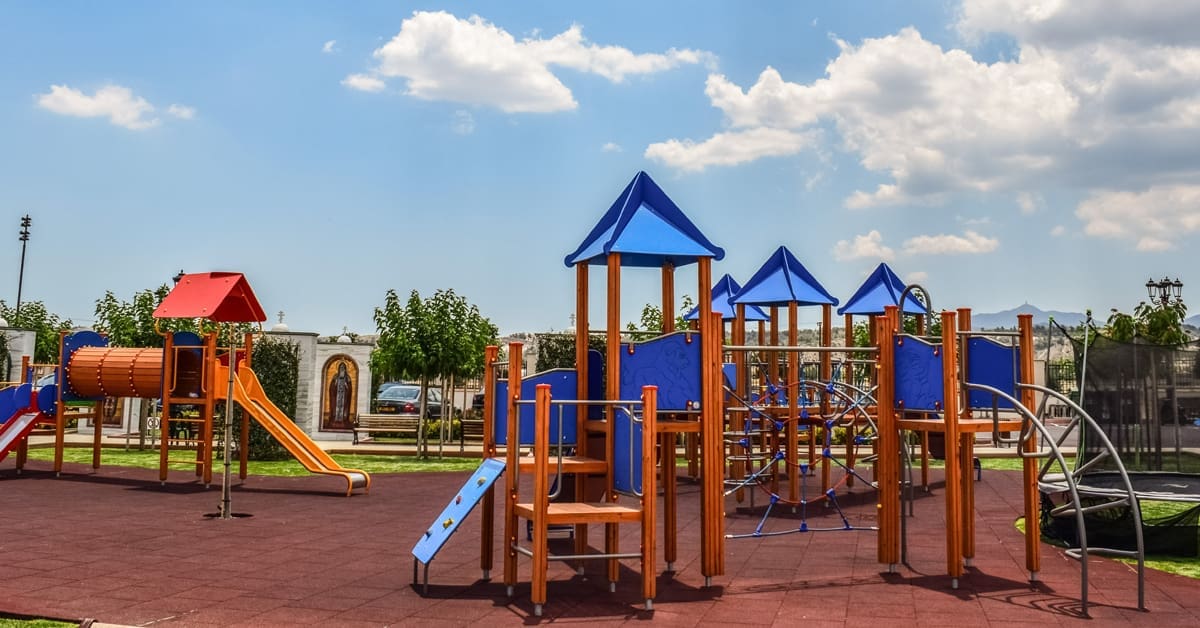Creating Fun and Secure Spaces for Children.
Designing a safe playground is crucial for ensuring children enjoy outdoor play while minimising the risk of injuries. A well-designed playground promotes physical activity and social interaction and provides peace of mind for parents and caregivers.
You can find out more about the systems we provide HERE
The following comprehensive guide will explore the key elements of playground safety design, from layout considerations to equipment selection and maintenance.
The Importance of Playground Safety Design
Playground safety design is not just about meeting regulatory requirements; it’s about creating an environment where children can explore, learn, and develop their skills without unnecessary risks.
With nearly 80% of playground injuries caused by falls, sound design and planning are essential to reduce accidents and ensure a positive play experience.
Key Elements of Playground Safety Design
1. Strategic Layout Planning
The layout of a playground is fundamental to its safety. A well-designed playground should:
- Separate age-appropriate play areas
- Minimise potential conflicts between different activities.
- Ensure clear sightlines for supervision.
- Manage traffic flow to prevent congestion.
Age Group Separation
Designating separate areas for different age groups, such as toddlers, preschoolers, and older children, is crucial to preventing injuries that may occur when children use equipment not designed for their age or developmental stage.
Activity Zoning
It’s essential to place equipment strategically to reduce the risk of collisions and conflicts:
- Keep highly active areas separate from quiet spots.
- Distribute popular equipment throughout the playground.
- Situate swing sets away from slide exits and other high-traffic areas.
Clear Sightlines
Clear sightlines throughout the playground are essential for adequate supervision. They allow parents, teachers, and caregivers to monitor children’s activities and respond quickly to any potential safety issues.
Traffic Flow Management
Plan the flow of foot traffic within the playground to avoid congested areas. Consider creating separate pathways for entrance and exit points, ensuring they don’t intersect with active play areas.
2. Fall Zone Safety
Fall zones are critical areas surrounding playground equipment where appropriate safety surfacing must be installed to cushion potential falls.
Understanding Fall Zones
A fall or use zone is the area under and around playground equipment where a child might fall.
These zones should extend:
- At least 6 feet in all directions from the edge of stationary equipment.
- For slides 4 feet or less in height, 6 feet from the end of the slide.
- For slides higher than 4 feet, the entrance height of the slide plus 4 feet from the end.
- For swings, two times the height of the pivot point in front of and behind the swing seats and 6 feet to the sides of the support structure.
Critical Fall Height
The critical fall height is the maximum height from which a user could fall. Safety flooring should be installed for equipment with a critical fall height of 0.6m or more, although it’s best practice to use safety surfacing beneath any equipment where falls could occur.
Appropriate Surfacing
Choosing the right surfacing material is crucial for fall zone safety. Options include:
- Loose-fill materials (e.g., wood chips, sand, pea gravel)
- Poured-in-place rubber surfacing
- Rubber tiles
- Synthetic turf with safety padding
The depth of the surfacing should correspond to the critical fall height of the equipment. For example:
- 6 inches of shredded/recycled rubber can protect up to a 10-foot fall height
- 9 inches of sand protects up to a 4-foot fall height
- 9 inches of wood chips protects up to a 10-foot fall height. 6
3. Equipment Selection and Placement
Choosing appropriate equipment and correct placement is the key to playground safety.
Age-Appropriate Equipment
Ensure that all equipment is suitable for the intended age group.
Factors to consider:
- Size and scale of equipment.
- Complexity of play features.
- Physical challenges appropriate for different developmental stages.
Equipment Spacing
The correct spacing between equipment is necessary to prevent collisions and allow for safe movement.
Consider:
- Leaving ample space between different play structures.
- Ensuring swing sets have sufficient clearance from other equipment.
- Providing clear pathways between different play zones.
Eliminating Hazards
Carefully inspect all equipment for potential hazards, including:
- Crush and shearing points
- Entanglement risks (e.g., loose ropes or cords)
- Entrapment hazards (gaps or openings that could trap a child)
- Sharp points, corners, or edges
- Suspended hazards 4
4. Accessibility and Inclusivity
A safe playground should be accessible and inclusive for children of all abilities.
Accessible Pathways
Ensure that pathways within the playground are:
- Wide enough for wheelchairs and other mobility devices
- Made of materials that are easy to navigate (e.g., poured-in-place rubber)
- Free from obstacles or tripping hazards
Inclusive Equipment
Include equipment that is accessible to children with various abilities, such as:
- Transfer platforms for wheelchair users
- Sensory play elements
- Ground-level play features
Clear Signage
Use clear, easy-to-read signs to:
- Designate age-appropriate play areas.
- Communicate playground rules.
- Provide contact information for the playground owner 1
5. Proper Drainage and Maintenance
A well-designed playground should include features that facilitate proper maintenance and drainage.
Drainage Systems
Implement effective drainage systems to prevent:
- Standing water, which can create slip hazards
- Erosion of safety surfacing
- Damage to equipment foundations
Regular Inspections and Maintenance
Design the playground with maintenance in mind:
- Allow easy access for inspection and repairs.
- Choose materials that are durable and weather-resistant.
- Plan for regular resurfacing and equipment checks.
6. Shade and Environmental Considerations
Incorporating shade and considering environmental factors can enhance playground safety.
Shade Structures
Include shade structures or natural shade to:
- Protect children from excessive sun exposure.
- Keep equipment surfaces cooler, preventing burns.
- Extend the usable hours of the playground.
Environmental Hazards
Consider potential environmental hazards:
- Remove or fence off areas with poisonous plants.
- Ensure proper fencing to prevent access to nearby roads or water bodies.
- Address any natural hazards specific to the playground’s location.
Implementing Playground Safety Design
When implementing a playground safety design, consider the following steps:
- Conduct a thorough site assessment: Evaluate the existing space, considering factors like topography, drainage, and natural features.
- Develop a comprehensive plan: Create a detailed design incorporating all safety elements discussed above.
- Choose certified equipment: Select playground equipment that meets or exceeds safety standards (e.g., ASTM, CPSC guidelines).
- Install proper surfacing: Ensure all fall zones have appropriate safety surfacing installed at the correct depth.
- Engage professional installers: Use certified playground installers to ensure correct and secure equipment set-up.
- Perform a post-installation inspection: Conduct a thorough safety inspection before opening the playground to the public.
- Establish a maintenance schedule: Create a regular maintenance plan to keep the playground safe.
Summary
Playground safety design is a multifaceted process that requires careful planning and attention to detail. By focusing on strategic layout, fall zone safety, appropriate equipment selection, accessibility, and ongoing maintenance, we can create fun, engaging, and safe playgrounds for children of all ages and abilities.
A well-designed playground goes beyond meeting minimum safety standards. It creates an environment where children can challenge themselves, develop new skills, and engage in imaginative play while minimising the risk of serious injuries. By prioritising safety in playground design, we invest in our children’s health, well-being, and development, creating spaces where they can truly thrive.
Get In Touch
Whatever the size or scope of your landscaping project, we are confident that we can accommodate your needs and provide an end product that matches or even exceeds your initial expectations.
We can provide free, competitive, and comprehensive, detailed quotes based on your plans upon request.
We’ll provide a detailed, free quotation that matches your needs with no strings attached. To contact us, click the button below and fill out our form.
Citations:
- https://playpowercanada.ca/resources/guide-to-playground-safety/
- https://discountplaygroundsupply.com/blog/playground-fall-zones-what-they-are-and-what-they-require/
- https://fallzonesafetysurfacing.com
- https://playgroundguardian.com/news-articles/ensuring-safety-key-considerations-for-planning-a-playground-build/
- https://www.natratex.co.uk/knowledgehub/what-is-fall-zone-playground/
- https://necpa.net/wp-content/uploads/2019/05/NECPA_-_Playground_Surfacing.pdf
- https://creativeplayuk.com/playground-guidance/
- https://fallzonesafetysurfacing.com/fallzone-playground-safety-check-list/

